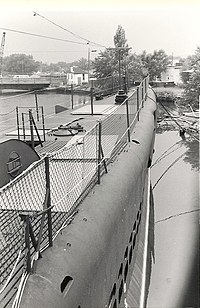The United States Navy, United States Coast Guard, and United States National Oceanic and Atmospheric Administration (NOAA) use a hull classification symbol to identify their ships by type and by individual ship within a type. The system is analogous to the pennant number system that the Royal Navy and other European and Commonwealth navies use.

A warship or combatant ship is a ship that is built and primarily intended for naval warfare. Usually they belong to the armed forces of a nation. As well as being armed, warships are designed to withstand damage and are typically faster and more maneuverable than merchant ships. Unlike a merchant ship, which carries cargo, a warship typically carries only weapons, ammunition and supplies for its crew. Warships usually belong to a navy, though they have also been operated by individuals, cooperatives and corporations.
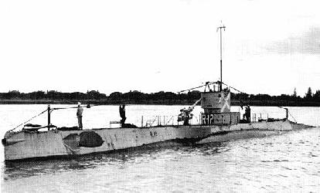
USS R-12 (SS-89) was an R-class coastal and harbor defense submarine of the United States Navy.

The Balao class was a design of United States Navy submarine used during World War II, and with 120 boats completed, the largest class of submarines in the United States Navy. An improvement on the earlier Gato class, the boats had slight internal differences. The most significant improvement was the use of thicker, higher yield strength steel in the pressure hull skins and frames, which increased their test depth to 400 feet (120 m). Tang actually achieved a depth of 612 ft (187 m) during a test dive, and exceeded that test depth when taking on water in the forward torpedo room while evading a destroyer.

USS Jacob Jones was a Tucker-class destroyer built for the United States Navy prior to the American entry into World War I. The ship was the first U.S. Navy vessel named in honor of Jacob Jones.
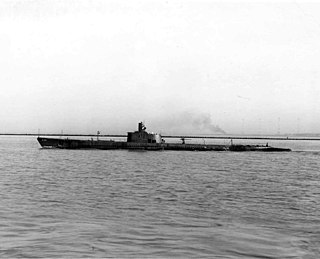
USS Silversides (SS/AGSS-236) is a Gato-class submarine, the first ship of the United States Navy to be named for the silversides.
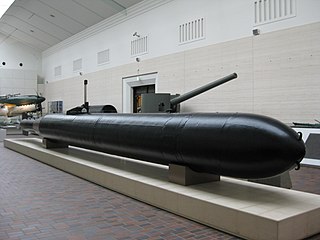
Kaiten were crewed torpedoes and suicide craft, used by the Imperial Japanese Navy in the final stages of World War II.

USS Torsk, hull number SS-423, is a Tench-class submarine built for the United States Navy during World War II. Armed with ten torpedo tubes, the Tench-class submarines were incremental developments of the highly-successful Gato-class submarines that formed the backbone of the US Navy's submarine force during the war. Torsk was laid down at the Portsmouth Navy Yard in June 1944, was launched in September that year, and commissioned in December.
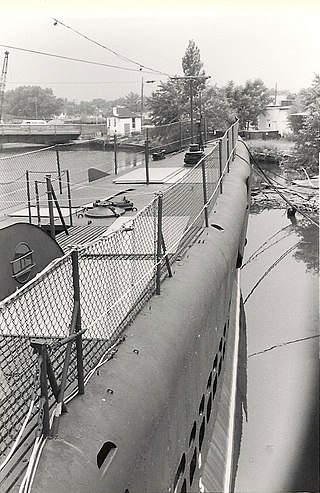
USS Ling is a Balao-class submarine of the United States Navy, named for the ling fish, also known as the cobia. The vessel was built during World War II, but was completed in the final months of the conflict and so saw no action. She was placed in reserve in 1946 until being converted into a training ship in 1960. In 1971, she was struck from the naval register and donated to the Submarine Memorial Association for use as a museum ship. The ship was grounded in the Hackensack River at the former location of the defunct New Jersey Naval Museum in Hackensack, New Jersey. Since 2016, Ling has been inaccessible to the public.

The United States' S-class submarines, often simply called S-boats, were the first class of submarines with a significant number built to United States Navy designs. They made up the bulk of the USN submarine service in the interwar years and could be found in every theater of operations. While not considered "Fleet Submarines" in the traditional sense of that term, they were the first submarines in the USN designed for open ocean, blue water operations. All previous submarines had been intended for harbor or coastal defense. These boats were intended to have greater speed and range than previous classes, with improved habitability and greater armament.
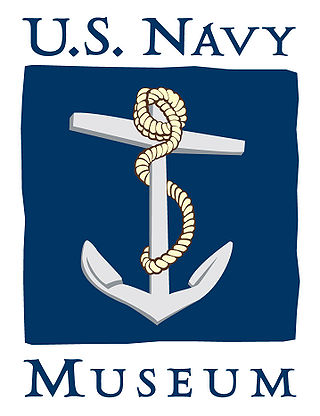
The National Museum of the United States Navy, or U.S. Navy Museum for short, is the flagship museum of the United States Navy and is located in the former Breech Mechanism Shop of the old Naval Gun Factory on the grounds of the Washington Navy Yard in Washington, D.C., United States.

An armed yacht was a yacht that was armed with weapons and was typically in the service of a navy. The word "yacht" was originally applied to small, fast and agile naval vessels suited to piracy and to employment by navies and coast guards against smugglers and pirates. Vessels of this type were adapted to racing by wealthy owners. The origin of civilian yachts as naval vessels, with their speed and maneuverability, made them useful for adaptation to their original function as patrol vessels. In the United States Navy armed yachts were typically private yachts expropriated for government use in times of war. Armed yachts served as patrol vessels during the Spanish–American War and the World Wars. In the latter conflicts, armed yachts were used as patrol vessels, convoy escorts, and in anti-submarine duties. In the United States, yachts were purchased from their owners with the owners given an option to repurchase their yacht at the close of hostilities.

A deck gun is a type of naval artillery mounted on the deck of a submarine. Most submarine deck guns were open, with or without a shield; however, a few larger submarines placed these guns in a turret.

The action of 24 July 1945 was one of the final naval battles during the Pacific Theater of World War II. In an attempt to destroy as many allied ships as possible, the Imperial Japanese Navy began arming their submarine fleet with manned torpedoes called kaitens. The Action of 24 July 1945 concerns the battle between a convoy of U.S. Navy warships off Luzon and the Japanese submarine I-53 and her kaitens.

I-48 was the last of three Type C cruiser submarines of the C2 sub-class built for the Imperial Japanese Navy. Commissioned in September 1944, she operated as a kaiten manned suicide attack torpedo carrier during World War II and was sunk in January 1945.
The second I-53 was the second of three Type C cruiser submarines of the C3 sub-class built for the Imperial Japanese Navy. Commissioned in February 1944, she operated primarily as a kaiten manned suicide attack torpedo carrier during the final year of World War II and sank the destroyer escort USS Underhill (DE-682). Surrendered at the end of the war, she was scuttled by the United States Navy in 1946.
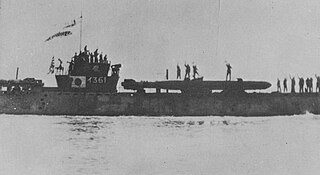
I-361 was an Imperial Japanese Navy Type D1 transport submarine. Completed and commissioned in May 1944, she served in World War II and conducted transport missions between Japan and Wake Island until she was converted into a kaiten suicide attack torpedo carrier 1945. She was sunk during her first kaiten mission in May 1945.
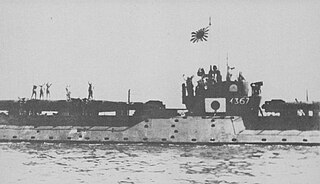
I-367 was an Imperial Japanese Navy Type D1 transport submarine. Completed and commissioned in August 1944, she served in World War II and conducted transport missions between Japan and outlying islands until she was converted into a kaiten suicide attack torpedo carrier. She survived the war, surrendered to Allied forces in 1945, and was scuttled in 1946.
